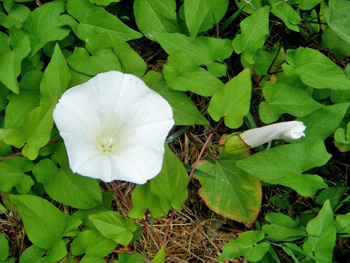Contents:
Common Names | Parts Usually Used | Plant(s) & Culture | Where Found | Medicinal Properties
Uses | Formulas or Dosages | Bibliography
Scientific Names

- Convolvulus sepium L.
- Convolvulaceae
- Morning-glory family
Common Names
- Devil’s vine
- Field bindweed
- Great bindweed
- Hedge lily
- Hsuan-hua
- Lady’s nightcap
- Rutland beauty
- Trailing bindweed
Parts Usually Used
Flowering plant, rootstock
Back to Top
Description of Plant(s) and Culture
Hedge bindweed is a perennial herbaceous vine; the trailing or twining stem is glabrous, angular, and from
Another variety: Field bindweed
Also, there is an herb called Wild Jalap
Back to Top
Where Found
Grows in waste places, thickets, and cultivated ground in the eastern half of the United States and in all of Europe.
Back to Top
Medicinal Properties
Cholagogue, febrifuge, purgative
Back to Top
Uses
Used primarily as a purgative but it helps reduce inflammation of mucous membranes and reduces fevers. The powdered root or a decoction made from the plant is used for the above listed. The fresh juice should be taken in small quantities only; in large quantities it produces constipation. Like all strong purgatives, hedge bindweed is not for extended use.
Back to Top
Formulas or Dosages
Decoction: boil
Juice: take
Powdered rootstock: take
Back to Top
Bibliography
![]() Eastern/Central Medicinal Plants
Eastern/Central Medicinal Plants, by Steven Foster and James A. Duke., Houghton Mifflin Company, 215 Park Avenue South, New York, NY 10000
![]() The Herb Book
The Herb Book, by John Lust, Bantam Books, 666 Fifth Avenue, New York, NY. copyright 1974.
![]() Chinese Medicinal Herbs
Chinese Medicinal Herbs, compiled by Shih-Chen Li, Georgetown Press, San Francisco, California, 1973.
![]() Webster’s New World Dictionary
Webster’s New World Dictionary, Third College Edition, Victoria Neufeldt, Editor in Chief, New World Dictionaries: A Division of Simon & Schuster, Inc., 15 Columbus Circle, New York, NY 10023
